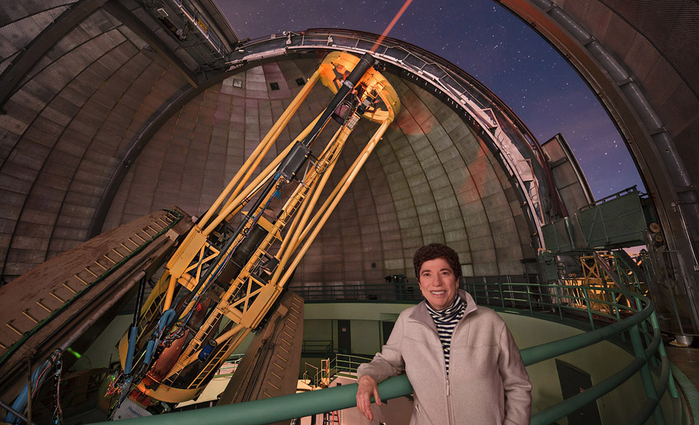Former Lawrence Livermore astrophysicist appointed director of UC Observatories
 (Download Image)
Claire Max, in front of the adaptive optics system at the Lick Observatory, is a leader in making near-diffraction-limited imaging possible on large ground-based telescopes. Photo courtesy of Laurie Hatch
(Download Image)
Claire Max, in front of the adaptive optics system at the Lick Observatory, is a leader in making near-diffraction-limited imaging possible on large ground-based telescopes. Photo courtesy of Laurie Hatch
Longtime Lawrence Livermore National Laboratory astrophysicist Claire Max has shifted her focus to a new frontier as the recently appointed director of the University of California Observatories (UCO).
After serving at the post on an interim basis for the past year, Max’s appointment to the directorship began July 1. Over the next five years, she will work with faculty, scientists and staff, as well as astronomers throughout the UC system, to devise a comprehensive strategic plan for the future of UCO, including development and funding for the Keck and Lick observatories and the proposed 30-meter telescope, conceived as the most advanced and powerful telescope on Earth.
To support the mission, the UC Office of the President is increasing funding for UCO’s operations by $2 million over the next three years.
A professor of astronomy and astrophysics, co-founder of the UC Center for Adaptive Optics at UC Santa Cruz, and a UC Observatories astronomer, Max spent 20 years as a physicist at Lawrence Livermore, where she was best known for her work on laser guide star adaptive optics, a technique for removing blurring caused by turbulence in the Earth’s atmosphere. She was the founding director of the Livermore branch of the Institute of Geophysics and Planetary Physics, and served as director of institutes in the physical sciences directorate, as well as director of University Relations. She joined the faculty at UC Santa Cruz in 2001.
Following her tenure at Lawrence Livermore, Max garnered numerous prestigious awards, including the Department of Energy’s E.O. Lawrence Award in Physics in 2004 and the American Astronomical Society’s Joseph Weber Award for Astronomical Instrumentation in 2015.
Max is currently researching advanced adaptive optics systems for large ground-based telescopes and using them to observe galaxies that have black holes in their cores. She also works closely with colleagues at UC Santa Cruz, the Keck Observatory, the California Institute of Technology and Lawrence Livermore.
In addition to her new responsibilities, Max will remain on the California Association for Research in Astronomy’s Board of Directors for Keck Observatory.
Contact
Jeremy Thomas[email protected]
925-422-5539
Related Links
UC ObservatoriesTags
Physical and Life SciencesCareers
Featured Articles







